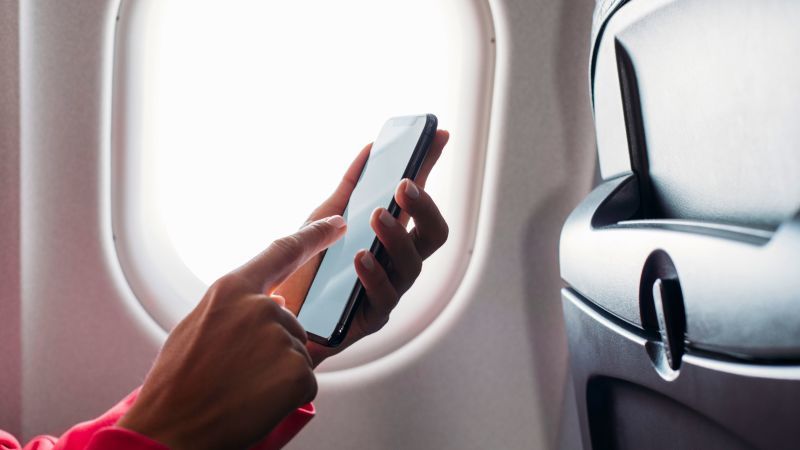Editor's note: The opinions expressed in this commentary are solely those of the author. CNN showcases the work of The Conversation, a collaboration between journalists and academics to provide news analysis and commentary. Content is solely produced by The Conversation.
cnn
—
We all know the routine by heart: “Make sure your seats are upright, tray tables stowed, window shades up, laptops stowed in overhead bins, and electronic devices in airplane mode.”
Now, the first four are reasonable, right? Window blinds should be up so we can see if there is an emergency, such as a fire. Tray tables should be put away and seats upright so we can get out of line quickly. Laptops can become projectiles in an emergency, as the seatback pockets are not strong enough to contain them.
And cell phones should be set to airplane mode so they can't cause an emergency on the plane, right? Well, it depends who you ask.
Navigation and air communications depend on radio services, which have been coordinated to minimize interference since the 1920s.
The digital technology used today is much more advanced than some of the older analog technologies we used even 60 years ago. Research has shown that personal electronic devices can emit a signal within the same frequency band as aircraft navigation and communications systems, creating what is known as electromagnetic interference.
But in 1992, the US Federal Aviation Authority and Boeing, in an independent study, investigated the use of electronic devices in aircraft jamming and found no problems with computers or other personal electronic devices during non-aircraft phases. flight reviews. (Takeoffs and landings are considered critical phases).
The US Federal Communications Commission also began creating frequency bandwidths reserved for different uses (such as cell phones and navigation and air communications) so that they do not interfere with each other. Governments around the world developed the same strategies and policies to prevent aviation interference problems. In the EU, electronic devices have been allowed to remain on since 2014.
Why then, with these global standards in place, has the aviation industry continued to ban the use of mobile phones? One of the problems lies in something you may not expect: floor interference.
Wireless networks are connected by a series of towers; Networks could become overloaded if all passengers flying over these ground networks use their phones. The number of passengers flown in 2021 exceeded 2.2 billion, and that's half the passenger figure in 2019. The wireless companies might be right here.
Of course, when it comes to mobile networks, the biggest change in recent years is the move to a new standard. Current 5G wireless networks, desirable for their higher data transfer speeds, have caused concern among many members of the aviation industry.
RF bandwidth is limited, but we are still trying to add more new devices to it. The aviation industry notes that the bandwidth spectrum of the 5G wireless network is notably close to the bandwidth spectrum reserved for aviation, which can cause interference with navigation systems near airports that help with the landing of the aircraft.
Airline executives worry about their cell phone's 5G network. Here's why (2021)
Airport operators in Australia and the United States have raised aviation security concerns related to the rollout of 5G, however it appears to have been rolled out without such issues in the European Union. Either way, it's prudent to limit cell phone use on airplanes while 5G-related issues are ironed out.
Most airlines now offer their customers free or pay-as-you-go Wi-Fi services. With new Wi-Fi technologies, passengers could, in theory, use their mobile phones to make video calls with friends or clients during the flight.
On a recent flight, I spoke to a flight attendant and asked her opinion about phone use during flights. It would be inconvenient for cabin crew to wait for passengers to finish their call to ask if they would like a drink or something to eat, she said. On a plane with more than 200 passengers, onboard service would take longer to complete if everyone made phone calls.
For me, the problem with in-flight phone use has more to do with the social experience of having 200+ people on a plane, potentially all talking at once. At a time when disruptive passenger behavior, including “air rage,” is becoming more common, in-flight phone use could be another trigger that changes the entire flight experience.
Disruptive behaviors take various forms, from failure to comply with safety requirements such as not wearing a seat belt, verbal altercations with other passengers and cabin crew, to physical altercations with passengers and cabin crew, generally identified as air rage.
In conclusion, the use of mobile phones during flight does not currently affect the operational capacity of the aircraft. But cabin crews may prefer not to delay providing onboard service to all passengers: there are a lot of people to serve.
However, 5G technology is encroaching on the radio bandwidth of aircraft navigation systems; We will need more research to answer the 5G question about interference with aircraft navigation during landings. Remember that when we talk about the two most critical phases of flight, takeoffs are optional, but landings are mandatory.













